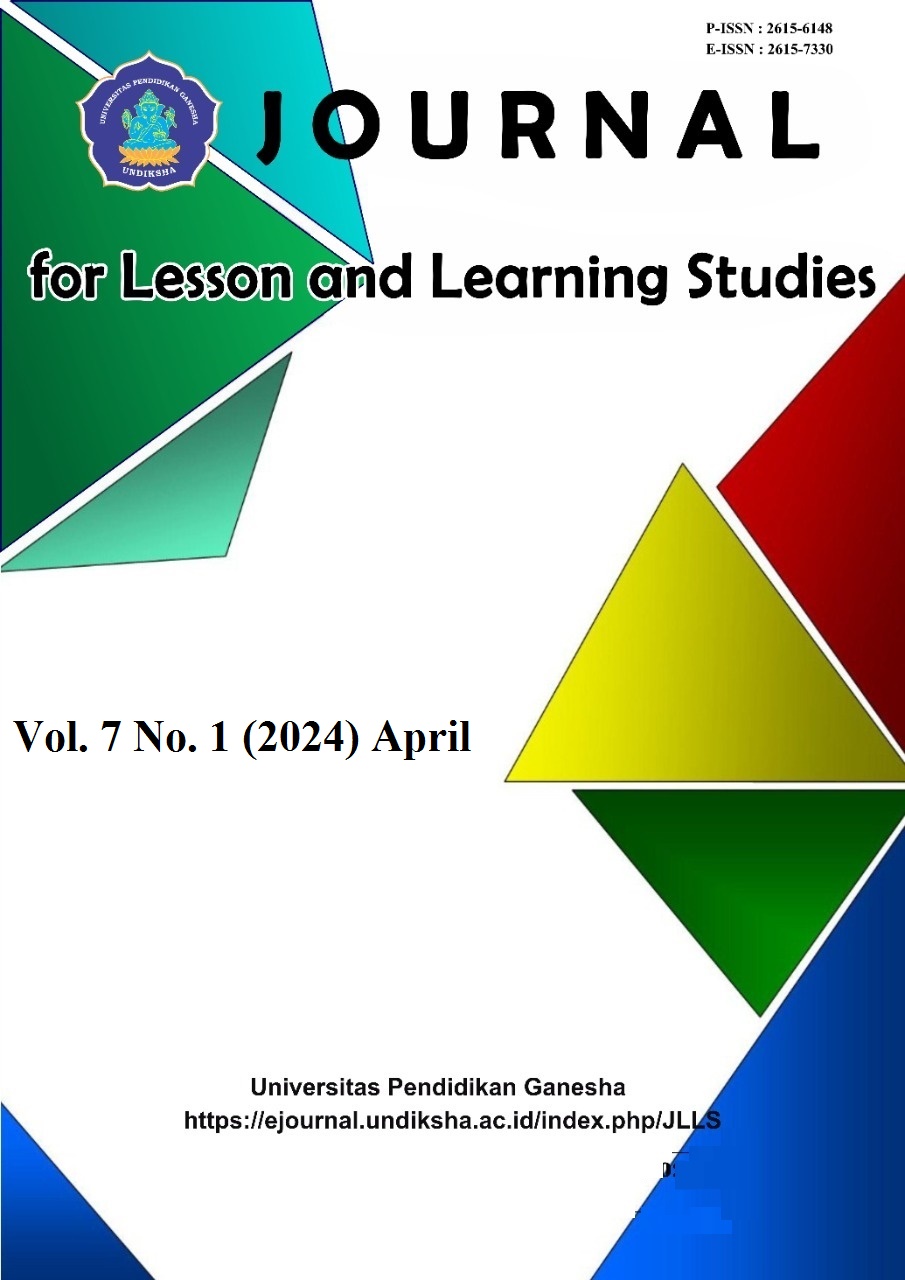Learning Management System Difficulties during the Learning Process in Higher Education
DOI:
https://doi.org/10.23887/jlls.v7i1.68665Keywords:
Learning Management System, Barriers and Difficulties, Higher EducationAbstract
The implementation of learning management system, lecturers must prepare the necessary materials and components. However, the fact is that there are 63% difficulties in compiling material in the learning management system. The research aims to analyze the impact of implementing learning using LMS in higher education and to find solutions to overcome obstacles and difficulties in implementing learning using a learning management system. The research method used is a survey by distributing instruments. Data collection techniques were by distributing instruments to 132 people consisting of lecturers and students who are directly involved in the learning process and conducting random interviews to ensure the correctness of the data from the survey. Analysis techniques using SPSS Version 25.0 by forming bar charts, line charts, and pie charts and interpreting them. As a result, the obstacles, difficulties, and impacts of using the learning management system during the learning process were found. The obstacles and difficulties lie in the preparation of materials, models, and assessment tools used which are not provided to students through the LMS. The material is not stated in the media used and is not given an assessment to students, so the impact is that students are unable to measure their abilities. In conclusion, every lecturer must prepare materials, models, and assessment instruments before using the learning management system in implementing course learning.
References
Adebayo, T. S., Agyekum, E. B., Altuntaş, M., Khudoyqulov, S., Zawbaa, H. M., & Kamel, S. (2022). Does information and communication technology impede environmental degradation? fresh insights from non-parametric approaches. Heliyon, 8(3), 1-13. https://doi.org/10.1016/j.heliyon.2022.e09108. DOI: https://doi.org/10.1016/j.heliyon.2022.e09108
Akeed, M. H., Qaidi, S., Ahmed, H. U., Faraj, R. H., Mohammed, A. S., Emad, W., Tayeh, B. A., & Azevedo, A. R. G. (2022). Ultra-high-performance fiber-reinforced concrete. Part IV: Durability properties, cost assessment, applications, and challenges. Case Studies in Construction Materials, 17(May), e01271.1-20. https://doi.org/10.1016/j.cscm.2022.e01271. DOI: https://doi.org/10.1016/j.cscm.2022.e01271
Al-Mamary, Y. H. S. (2022). Understanding the use of learning management systems by undergraduate university students using the UTAUT model: Credible evidence from Saudi Arabia. International Journal of Information Management Data Insights, 2(2), 1-11. https://doi.org/10.1016/j.jjimei.2022.100092. DOI: https://doi.org/10.1016/j.jjimei.2022.100092
Alturki, U., & Aldraiweesh, A. (2021). Application of learning management system (Lms) during the covid-19 pandemic: A sustainable acceptance model of the expansion technology approach. Sustainability (Switzerland), 13(19), 1-16. https://doi.org/10.3390/su131910991. DOI: https://doi.org/10.3390/su131910991
Ariono, B., Wasesa, M., & Dhewanto, W. (2022). The Drivers, Barriers, and Enablers of Building Information Modeling (BIM) Innovation in Developing Countries: Insights from Systematic Literature Review and Comparative Analysis. Buildings, 12(11), 1-22. https://doi.org/10.3390/buildings12111912. DOI: https://doi.org/10.3390/buildings12111912
Asamoah, M. K. (2021). ICT officials’ opinion on deploying Open Source Learning Management System for teaching and learning in universities in a developing society. E-Learning and Digital Media, 18(1), 18–38. https://doi.org/10.1177/2042753020946280. DOI: https://doi.org/10.1177/2042753020946280
Assen, J. H. E., & Otting, H. (2022). Teachers’ collective learning: To what extent do facilitators stimulate the use of social context, theory, and practice as sources for learning? Teaching and Teacher Education, 114(6), 103702.1-11. https://doi.org/10.1016/j.tate.2022.103702. DOI: https://doi.org/10.1016/j.tate.2022.103702
Behera, R. K., Bala, P. K., Rana, N. P., & Kayal, G. (2022). Self-promotion and online shaming during COVID-19: A toxic combination. International Journal of Information Management Data Insights, 2(2), 100117.1-15. https://doi.org/10.1016/j.jjimei.2022.100117. DOI: https://doi.org/10.1016/j.jjimei.2022.100117
Campos, C. I. de, Pitombo, C. S., Delhomme, P., & Quintanilha, J. A. (2020). Comparative analysis of data reduction techniques for questionnaire validation using self-reported driver behaviors. Journal of Safety Research, 73(June 2020), 133–142. https://doi.org/10.1016/j.jsr.2020.02.004. DOI: https://doi.org/10.1016/j.jsr.2020.02.004
Degner, M., Moser, S., & Lewalter, D. (2022). Digital media in institutional informal learning places: A systematic literature review. Computers and Education Open, 3, 100068. https://doi.org/10.1016/j.caeo.2021.100068. DOI: https://doi.org/10.1016/j.caeo.2021.100068
Díez, F., Villa, A., López, A. L., & Iraurgi, I. (2020). Impact of quality management systems in the performance of educational centers: educational policies and management processes. Heliyon, 6(4), e03824. https://doi.org/https://doi.org/10.1016/j.heliyon.2020.e03824. DOI: https://doi.org/10.1016/j.heliyon.2020.e03824
Gawer, A. (2021). Digital platforms’ boundaries: The interplay of firm scope, platform sides, and digital interfaces. Long Range Planning, 54(5), 1-16. https://doi.org/10.1016/j.lrp.2020.102045. DOI: https://doi.org/10.1016/j.lrp.2020.102045
Ghani, N. A., Teo, P. C., Ho, T. C. F., Choo, L. S., Kelana, B. W. Y., Adam, S., & Ramliy, M. K. (2022). Bibliometric Analysis of Global Research Trends on Higher Education Internationalization Using Scopus Database: Towards Sustainability of Higher Education Institutions. Sustainability (Switzerland), 14(14), 1-15. https://doi.org/10.3390/su14148810. DOI: https://doi.org/10.3390/su14148810
Gupta, T., Burke, K. A., & Greenbowe, T. J. (2022). Shifting the ownership of learning from instructor to students through student-led instructor-facilitated guided-inquiry learning. In Teaching Innovation in University Education: Case Studies and Main Practices, 69–98. https://doi.org/10.4018/978-1-6684-4441-2.ch005. DOI: https://doi.org/10.4018/978-1-6684-4441-2.ch005
Hansen, J. A., & Tummers, L. (2020). A Systematic Review of Field Experiments in Public Administration. Public Administration Review, 80(6), 921–931. https://doi.org/10.1111/puar.13181. DOI: https://doi.org/10.1111/puar.13181
Harpe, S. E. (2015). How to analyze Likert and other rating scale data. Currents in Pharmacy Teaching and Learning, 7(6), 836–850. https://doi.org/10.1016/j.cptl.2015.08.001. DOI: https://doi.org/10.1016/j.cptl.2015.08.001
Hwang, G. J., Chang, C. C., & Chien, S. Y. (2022). A motivational model‐based virtual reality approach to prompting learners’ sense of presence, learning achievements, and higher‐order thinking in professional safety training. British Journal of Educational Technology. https://doi.org/10.1111/bjet.13196. DOI: https://doi.org/10.1111/bjet.13196
Iflaifel, M., Lim, R. H., Ryan, K., & Crowley, C. (2020). Resilient Health Care: A systematic review of conceptualisations, study methods and factors that develop resilience. BMC Health Services Research, 20(1), 1–21. https://doi.org/10.1186/s12913-020-05208-3. DOI: https://doi.org/10.1186/s12913-020-05208-3
Kumar, A., Krishnamurthi, R., Bhatia, S., Kaushik, K., Ahuja, N. J., Nayyar, A., & Masud, M. (2021). Blended Learning Tools and Practices: A Comprehensive Analysis. IEEE Access, 9. https://doi.org/10.1109/ACCESS.2021.3085844. DOI: https://doi.org/10.1109/ACCESS.2021.3085844
Laho, N. S. (2019). Enhancing School-Home Communication Through Learning Management System Adoption: Parent and Teacher Perceptions and Practices. School Community Journal, 29(1), 117–142. https://eric.ed.gov/?id=EJ1219893.
Lampropoulos, G., Siakas, K., & Anastasiadis, T. (2019). Internet of Things in the Context of Industry 4.0: An Overview. International Journal of Entrepreneurial Knowledge, 7(1), 4–19. https://doi.org/10.2478/ijek-2019-0001. DOI: https://doi.org/10.2478/ijek-2019-0001
Lumbantoruan, J. H. (2022). PENGEMBANGAN MODUL MATEMATIKA MATERI TURUNAN Universitas Kristen Indonesia , Jakarta , Indonesia E-mail : Abstrak PENDAHULUAN Dalam penelitian Purwaningsih , ( 2016 ) terlihat adanya peningkatan aktivitas peserta didik dalam belajar yang dibantu oleh modu. AKSIOMA: Jurnal Program Studi Pendidikan Matematika, 11(4), 2593–2609. https://doi.org/http://dx.doi.org/10.24127/ajpm.v11i4.5716. DOI: https://doi.org/10.24127/ajpm.v11i4.5716
Matete, R. E., Kimario, A. E., & Behera, N. P. (2023). Review on the use of eLearning in teacher education during the corona virus disease (COVID-19) pandemic in Africa. Heliyon, 9(2), e13308.1-13. https://doi.org/10.1016/j.heliyon.2023.e13308. DOI: https://doi.org/10.1016/j.heliyon.2023.e13308
McComb, C., & Jablokow, K. (2022). A conceptual framework for multidisciplinary design research with example application to agent-based modeling. Design Studies, 78(1), 101074.1-13. https://doi.org/10.1016/j.destud.2021.101074. DOI: https://doi.org/10.1016/j.destud.2021.101074
Meyerowitz-Katz, G., & Merone, L. (2020). A systematic review and meta-analysis of published research data on COVID-19 infection fatality rates. International Journal of Infectious Diseases, 101(12), 138–148. https://doi.org/10.1016/j.ijid.2020.09.1464. DOI: https://doi.org/10.1016/j.ijid.2020.09.1464
Mncube, L. S., & Mthethwa, L. C. (2022). Potential ethical problems in the creation of open educational resources through virtual spaces in academia. Heliyon, 8(6), e09623.1-8. https://doi.org/10.1016/j.heliyon.2022.e09623. DOI: https://doi.org/10.1016/j.heliyon.2022.e09623
Müller, F. A., & Wulf, T. (2020). Technology-supported management education: a systematic review of antecedents of learning effectiveness. International Journal of Educational Technology in Higher Education, 17(1). https://doi.org/10.1186/s41239-020-00226-x. DOI: https://doi.org/10.1186/s41239-020-00226-x
Nurse-Clarke, N., & Joseph, M. (2022). An exploration of technology acceptance among nursing faculty teaching online for the first time at the onset of the COVID-19 pandemic. Journal of Professional Nursing, 41(October 2021), 8–18. https://doi.org/10.1016/j.profnurs.2022.04.002. DOI: https://doi.org/10.1016/j.profnurs.2022.04.002
Olan, F., Ogiemwonyi Arakpogun, E., Suklan, J., Nakpodia, F., Damij, N., & Jayawickrama, U. (2022). Artificial intelligence and knowledge sharing: Contributing factors to organizational performance. Journal of Business Research, 145(February), 605–615. https://doi.org/10.1016/j.jbusres.2022.03.008. DOI: https://doi.org/10.1016/j.jbusres.2022.03.008
Pal, D., & Vanijja, V. (2020). Perceived usability evaluation of Microsoft Teams as an online learning platform during COVID-19 using system usability scale and technology acceptance model in India. Children and Youth Services Review, 119. https://doi.org/10.1016/j.childyouth.2020.105535. DOI: https://doi.org/10.1016/j.childyouth.2020.105535
Raković, M., Bernacki, M. L., Greene, J. A., Plumley, R. D., Hogan, K. A., Gates, K. M., & Panter, A. T. (2022). Examining the critical role of evaluation and adaptation in self-regulated learning. Contemporary Educational Psychology, 68. https://doi.org/10.1016/j.cedpsych.2021.102027. DOI: https://doi.org/10.1016/j.cedpsych.2021.102027
Ramalingam, S., Yunus, M. M., & Hashim, H. (2022). Blended Learning Strategies for Sustainable English as a Second Language Education: A Systematic Review. Sustainability (Switzerland), 14(13), 1–17. https://doi.org/10.3390/su14138051. DOI: https://doi.org/10.3390/su14138051
Sambodo, M. T., Yuliana, C. I., Hidayat, S., Novandra, R., Handoyo, F. W., Farandy, A. R., Inayah, I., & Yuniarti, P. I. (2022). Breaking barriers to low-carbon development in Indonesia: deployment of renewable energy. Heliyon, 8(4), e09304.1-11. https://doi.org/10.1016/j.heliyon.2022.e09304. DOI: https://doi.org/10.1016/j.heliyon.2022.e09304
Shim, T. E., & Lee, S. Y. (2020). College students’ experience of emergency remote teaching due to COVID-19. Children and Youth Services Review, 119. https://doi.org/10.1016/j.childyouth.2020.105578. DOI: https://doi.org/10.1016/j.childyouth.2020.105578
Shipman, D., Roa, M., Hooten, J., & Wang, Z. J. (2012). Using the analytic rubric as an evaluation tool in nursing education: The positive and the negative. Nurse Education Today, 32(3), 246–249. https://doi.org/10.1016/j.nedt.2011.04.007. DOI: https://doi.org/10.1016/j.nedt.2011.04.007
Slovaček, K. A., & Čosić, G. (2020). The Role of Parents during the COVID19 Pandemic in Croatia. Studies in Educational Management, 8(8), 9–17. https://doi.org/10.32038/sem.2020.08.02. DOI: https://doi.org/10.32038/sem.2020.08.02
Suyadi, Nuryana, Z., Sutrisno, & Baidi. (2022). Academic reform and sustainability of Islamic higher education in Indonesia. International Journal of Educational Development, 89, 102534. https://doi.org/10.1016/j.ijedudev.2021.102534. DOI: https://doi.org/10.1016/j.ijedudev.2021.102534
Syakur, A. (2020). The Effectiveness of English Learning Media through Google Classroom in Higher Education. Britain International of Linguistics Arts and Education (BIoLAE) Journal, 2(1), 475–483. https://doi.org/10.33258/biolae.v2i1.218. DOI: https://doi.org/10.33258/biolae.v2i1.218
Tao, J., & Gao, X. (2022). Teaching and learning languages online: Challenges and responses. System, 107(May), 102819.1-9. https://doi.org/10.1016/j.system.2022.102819. DOI: https://doi.org/10.1016/j.system.2022.102819
Taufan, M. Y. (2022). Professional Development of Teachers, Competencies, Educational Facilities and Infrastructure on Teacher Performance and Learning Achievement of High School Students in Makassar City. Golden Ratio of Social Science and Education, 2(1), 24–38. https://doi.org/10.52970/grsse.v2i1.168. DOI: https://doi.org/10.52970/grsse.v2i1.168
Ustaoğlu, F., Tepe, Y., & Taş, B. (2020). Assessment of stream quality and health risk in a subtropical Turkey river system: A combined approach using statistical analysis and water quality index. Ecological Indicators, 113(May 2020), 105815.1-12. https://doi.org/10.1016/j.ecolind.2019.105815. DOI: https://doi.org/10.1016/j.ecolind.2019.105815
Wu, B., Widanage, W. D., Yang, S., & Liu, X. (2020). Battery digital twins: Perspectives on the fusion of models, data and artificial intelligence for smart battery management systems. Energy and AI, 1(8), 100016.1-12. https://doi.org/10.1016/j.egyai.2020.100016. DOI: https://doi.org/10.1016/j.egyai.2020.100016
Wu, W., Zhu, D., Liu, W., & Wu, C. H. (2022). Empirical research on smart city construction and public health under information and communications technology. Socio-Economic Planning Sciences, 80(9), 100994.1-40. https://doi.org/10.1016/j.seps.2020.100994. DOI: https://doi.org/10.1016/j.seps.2020.100994
Yeh, C. Y. C., Cheng, H. N. H., Chen, Z. H., Liao, C. C. Y., & Chan, T. W. (2019). Enhancing achievement and interest in mathematics learning through Math-Island. Research and Practice in Technology Enhanced Learning, 14(1). https://doi.org/10.1186/s41039-019-0100-9. DOI: https://doi.org/10.1186/s41039-019-0100-9
Zainuddin, Z., & Perera, C. J. (2018). Supporting students’ self-directed learning in the flipped classroom through the LMS TES BlendSpace. On the Horizon, 26(4), 281–290. https://doi.org/10.1108/OTH-04-2017-0016. DOI: https://doi.org/10.1108/OTH-04-2017-0016
Ziraba, G. C., Akwene, A. A., & Shiynsa, M. . (2020). The Adoption and Use of Moodle Learning Management System in Higher Institutions of Learning: A Systematic Literature Review. American Journal of Online and Distance Learning, 2(1), 1–21. https://doi.org/10.47672/ajodl.489.
Downloads
Published
How to Cite
Issue
Section
License
Copyright (c) 2023 Rabiyatul Jasiyah, Emma Rumahlewang, Bertha Ireni Mundung, Syusantie Sylfia Sairdama, Nanda Saputra

This work is licensed under a Creative Commons Attribution-ShareAlike 4.0 International License.
Authors who publish with the Journal for Lesson and Learning Studies agree to the following terms:
- Authors retain copyright and grant the journal the right of first publication with the work simultaneously licensed under a Creative Commons Attribution License (CC BY-SA 4.0) that allows others to share the work with an acknowledgment of the work's authorship and initial publication in this journal.
- Authors are able to enter into separate, additional contractual arrangements for the non-exclusive distribution of the journal's published version of the work (e.g., post it to an institutional repository or publish it in a book), with an acknowledgment of its initial publication in this journal.
- Authors are permitted and encouraged to post their work online (e.g., in institutional repositories or on their website) prior to and during the submission process, as it can lead to productive exchanges, as well as earlier and greater citation of published work. (See The Effect of Open Access)




